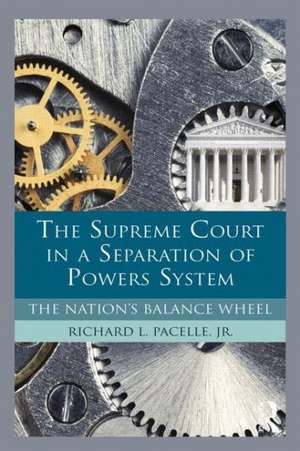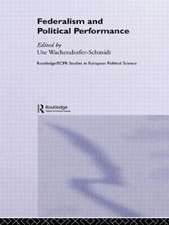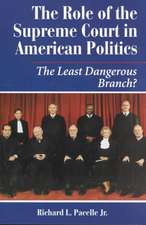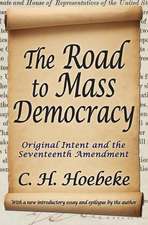The Supreme Court in a Separation of Powers System: The Nation's Balance Wheel
Autor Richard Pacelleen Limba Engleză Paperback – 21 ian 2015
Pacelle analyzes the Court’s interaction in the separation of powers system, detailing its relationship to the presidency, Congress, the bureaucracy, public opinion, interest groups, and the vast system of lower courts. The niche the Court occupies and the role it plays in American government reflect aspects of both the legal and political models. The Court has legal duties and obligations as well as some freedom to exercise its collective political will. Too often those studying the Court have examined it in isolation, but this book urges scholars and students alike to think more broadly and situate the highest court as the "balance wheel" in the American system.
| Toate formatele și edițiile | Preț | Express |
|---|---|---|
| Paperback (1) | 461.03 lei 6-8 săpt. | |
| Taylor & Francis – 21 ian 2015 | 461.03 lei 6-8 săpt. | |
| Hardback (1) | 1113.12 lei 6-8 săpt. | |
| Taylor & Francis – 19 ian 2015 | 1113.12 lei 6-8 săpt. |
Preț: 461.03 lei
Preț vechi: 542.39 lei
-15% Nou
Puncte Express: 692
Preț estimativ în valută:
88.23€ • 91.77$ • 72.84£
88.23€ • 91.77$ • 72.84£
Carte tipărită la comandă
Livrare economică 14-28 aprilie
Preluare comenzi: 021 569.72.76
Specificații
ISBN-13: 9780415894302
ISBN-10: 0415894301
Pagini: 326
Ilustrații: 11 black & white tables
Dimensiuni: 152 x 229 x 18 mm
Greutate: 0.45 kg
Ediția:1
Editura: Taylor & Francis
Colecția Routledge
Locul publicării:Oxford, United Kingdom
ISBN-10: 0415894301
Pagini: 326
Ilustrații: 11 black & white tables
Dimensiuni: 152 x 229 x 18 mm
Greutate: 0.45 kg
Ediția:1
Editura: Taylor & Francis
Colecția Routledge
Locul publicării:Oxford, United Kingdom
Cuprins
Selected Contents: Introduction. Recalculating: Getting to the Supreme Court with a GPS 1. The Supreme Court: The Nation’s Balance Wheel? 2. The Supreme Court and the President: An "Informal and Limited Alliance" 3. The Supreme Court and Congress: The First Shall be Last, Will the Last be First? 4. The Supreme Court and the Bureaucracy: The Clash of Kafkaesque Forces? 5. Public Opinion: The Two Faces of Janus 6. "Lobbying" the Judicial Branch: May it Please the Court? 7. The Supreme Court and the Lower Courts: A Bureaucracy to Call Your Own 8. Conclusion
Notă biografică
Richard L. Pacelle, Jr., is Professor and Head of the Department of Political Science at the University of Tennesse. His research focuses on the U.S. Supreme Court and he is the recipient of numerous awards for both teaching and scholarship.
Recenzii
"The splendid isolation in which the Supreme Court operates is a myth, as this volume makes clear. A range of external actors and influences affect the behavior of the Supreme Court, and failing to properly appreciate this fact runs the risk of seriously misunderstanding the institution. Professor Pacelle offers readers a comprehensive view of the Court in context, one marked by both depth and breadth, and does so with his usual flair and style." –Wendy L. Martinek, Binghamton University.
"The Supreme Court in a Separation of Powers System is an accessible and engaging look at the role of the Court in American politics. It stands out for its careful consideration of the Court’s interactions with the other branches of government, the public, interest groups, and lower courts. This is a rare feat and a most welcome addition to the field." – Paul Collins University of Massachusetts, Amherst
" Pacelle includes a rich array of institutional literature beyond public law and judicial behavior and encourages readers to take different “routes” through the book, depending upon the readers' methodological comfort and interest....Pacelle’s analysis remains convincing because both orientations have strained, but not broken, the Supreme Court’s legitimacy. This comprehensive treatment flows with a direct, even cheeky, writing style."--J. Farrier, University of Louisville
"The Supreme Court in a Separation of Powers System is an accessible and engaging look at the role of the Court in American politics. It stands out for its careful consideration of the Court’s interactions with the other branches of government, the public, interest groups, and lower courts. This is a rare feat and a most welcome addition to the field." – Paul Collins University of Massachusetts, Amherst
" Pacelle includes a rich array of institutional literature beyond public law and judicial behavior and encourages readers to take different “routes” through the book, depending upon the readers' methodological comfort and interest....Pacelle’s analysis remains convincing because both orientations have strained, but not broken, the Supreme Court’s legitimacy. This comprehensive treatment flows with a direct, even cheeky, writing style."--J. Farrier, University of Louisville
Descriere
Pacelle analyzes the US Sumpreme Court’s interaction in the separation of powers system, detailing its relationship to the presidency, Congress, the bureaucracy, public opinion, interest groups, and the vast system of lower courts. The niche the Court occupies and the role it plays in American government reflect aspects of both the legal and political models. The Court has legal duties and obligations as well as some freedom to exercise its collective political will. Too often those studying the Court have examined it in isolation, but this book urges scholars and students alike to think more broadly and situate the highest court as the "balance wheel" in the American system.















